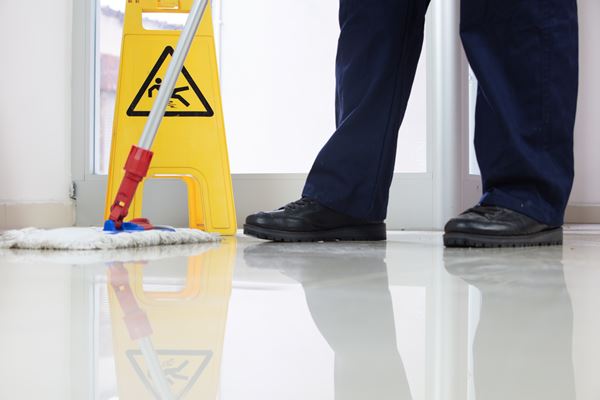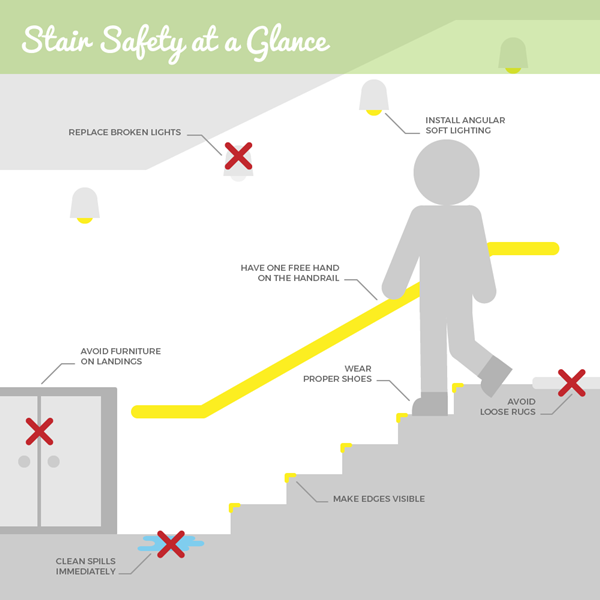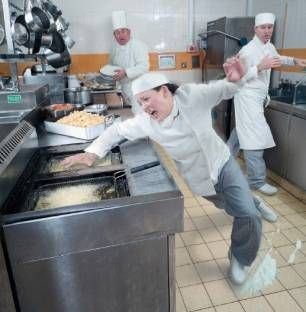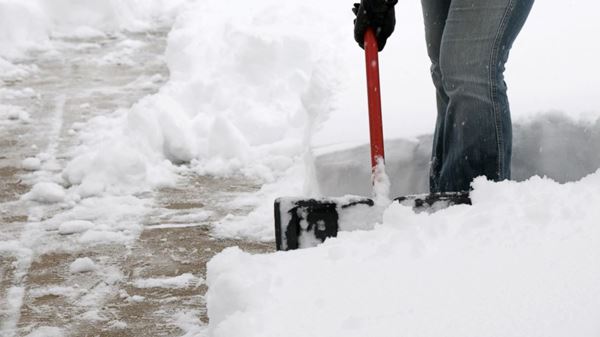Slips and trips
Shattered Lives - Kitchen
Falls due to slips or trips remain a significant contributor to the risk of injury and ill health at work. Recent statistics for Great Britain show that slips, trips and falls are the biggest cause of employer-reported non-fatal injuries to employees, accounting for 30% of all specified injuries.
It is estimated that over 6 million working days were lost last year because of non-fatal workplace injuries, with plenty of physical harm done to employees and significant costs to employers. But almost all slips and trips can be prevented, often with simple inexpensive interventions.
Understanding and preventing slips
Slip and trip accidents happen for a number of reasons. The following model will help you understand the factors that can contribute to slip accidents and the action to take to prevent them . It is called the slip potential model. One or more of these factors may play a part in any slip accident.
Contamination
People rarely slip on a clean, dry floor. Contamination is involved in almost all slip accidents, that is anything that ends up on a floor, eg rain water, oil, dust etc. If a floor has a smooth surface (eg standard vinyl, ceramic tiles or varnished wood), even a tiny amount of contamination can be a real slip problem.
Cleaning

Effective cleaning is an important way of employers managing slips and trips risks
Cleaning is important in managing slips and trips for two reasons:
- cleaning is supposed to deal with contamination that would otherwise lead to slip accidents but
- the cleaning process often introduces slip or trip hazards, ie wet floors, trailing cables, etc
Make sure that staff who carry out cleaning duties have the right information, instruction and training to enable them to carry out their work safely and effectively.
For further information see the information sheet Slips and trips: The importance of floor cleaning (PDF) .
People
How people act and behave in their work environment can affect slips and trips.
- deal with spillages instead of waiting for someone else to deal with it
- wear footwear (Personal Protective Equipment - PPE) as it can make a difference
- rushing, carrying large objects which prevents them from seeing where they are going or becoming distracted whilst walking eg. by using a mobile phone

Flooring
The floor in a workplace must be suitable for the type of work activity taking place on it. Floors must be suitable, in good condition and free from obstructions. People should be able to move around safely.
Where a floor is likely to be subject to frequent contamination, people should still be able to walk on it without the risk of slipping. See Assessing the slip resistance of flooring, which also describes the relevant British and European standards.
For detailed information on flooring see Safer surfaces to walk on, CIRIA
Assessing the slip resistance of flooring: a technical info sheet
Environment
Environmental issues can increase the risk of, or prevent slips and trips, so it is important to take them into consideration. But firstly, what does the term 'Environment' mean as regards slips and trips? Lighting (natural or otherwise), loud or unfamiliar noises, the weather, humidity, condensation etc.
The following gives an indication of how they can affect slips and trips
- Too much light on a shiny floor can cause glare and stop people from seeing hazards on the floor and stairs.
- Too little light will also prevent people from seeing hazards on the floor and stairs.
- Unfamiliar and loud noises may be distracting.
- If rainwater gets onto a smooth surface inside or outside of a building, it may create a slip hazard. Good entrance design (eg canopies) can help.
- Cold weather can cause frost and ice to form, which may create slippery surfaces. (see icy conditions faq)
- Condensation may make a smooth floor slippery.
Footwear
Choosing slip-resistant footwear from the whole host of products on the market can be difficult. Sole descriptions are varied, from 'improving the grip performance' to 'excellent multi-directional slip-resistance'. Often, footwear is just described as 'slip-resistant' and the brochure does not describe the conditions for which the footwear is most suitable.
Footwear selection has to take account of a number of factors in addition to slip resistance, such as comfort, durability and any other safety features required, such as toe protection. The final choice may have to be a compromise.
Understanding and preventing trips
The majority of trips are caused by obstructions in walkways. The rest are caused by uneven surfaces. Preventing these accidents is often simple and cost-effective.
You need to get all three right (walkways, housekeeping and design and maintenance), to prevent tripping accidents.
Walkways
Check for a suitable walkways - Are they in the right place, are they being used, are they available for use? What tasks are taking place on the walkway, is the task preventing the employee from seeing where he is going for example.
Housekeeping
It is not just good enough to have a walkway, it must be kept clear, no trailing wires, no obstructions. Employees and cleaners need to have 'a see it, sort it' attitude to ensure these and other work areas are kept clear. Is the cleaning regime effective? Are there enough bins, storage facilities etc?
Design and maintenance
Is the floor suitable for the environment, fitted correctly and properly maintained. Are the walkways wide enough & level. Are stairs suitable, are risers consistent, are nosings highlighted where necessary, are usable handrails available. Environmental factors also fall into this category, is the lighting good enough for employees to see hazards, what about distractions that might prevent them from seeing where they are going.

Stairs
Stairs should be in safe condition and be of suitable design and dimensions for their use, as set out in Building Regulations Approved Document K. You should consider whether they:
- are well lit;
- have handrails at an appropriate height that contrasts with the surroundings;
- have good slip resistance properties, particularly at the leading edge;
- have clearly marked edges;
- are free from trip hazards or obstacles;
- stairs or steps of 3 or more risers require a handrail.
What do employers need to do?
The Health and Safety at Work Act 1974 requires employers to ensure the health and safety of all employees and anyone affected by their work, so far as is reasonably practicable, which means balancing the level of risk against the measures needed to control the risk in terms of money, time or trouble. This includes taking steps to control slip and trip risks.
The Management of Health and Safety at Work Regulations 1999 require employers to assess risks (including slip and trip risks) and, where necessary, take action to address them. The Workplace (Health, Safety and Welfare) Regulations 1992 require floors to be suitable, in good condition and free from obstructions. People should be able to move around safely.
How do you Control the risk of slips and trips in the workplace?
Focus on the risks that really matter in your workplace - the ones with the potential to cause harm. In many instances, straightforward measures can readily control risks, for example, ensuring spillages are cleaned up promptly so people do not slip or cupboard drawers kept closed to ensure people do not trip. For most, that means simple, cheap and effective measures to ensure your most valuable asset - your workforce - is protected.
Risk assessment
Underetake a risk assessment to identify potential slips and trip hazards in the workplace and put in place suitable and sufficient control measures. When undertakng your risk assessment consider the slip potential model.
What can employees do?
Employees have general duties under the Health and Safety at Work Act 1974 and the Management of Health and Safety at Work Regulations 1999. You must take reasonable care of yourselves and others who may be affected by your actions and comply with your employers arrangements for managing health and safety.
If you are an employee or working under someone else's control, the law says you must:
- inform your employer of any work situation you consider dangerous, or of any shortcoming in their protection arrangements for health and safety
- use all work items provided by your employer correctly, in accordance with your training and the instructions you received to use them safely
How can you help to prevent slips and trips in your workplace?
- Report near misses and accidents promptly to your employer
- If you see slip and trip risks, try to sort them out or inform your employer
- Help to keep floors clean and dry
- Clear up spillages straight away
- If you think of ways of preventing contamination (water, oils, cardboard, waste etc) from getting onto the floor, suggest them to your employer
- Avoid causing trailing cables
- Keep place of work clear of obstacles
- Ask your employer to mark slopes and changes of levels
- If there isn't adequate lighting, report it
- Follow all safety advice
Slips in kitchens

Slip accidents in kitchens are very common and injuries can be very serious, but slips don’t have to happen. Everyone has a part to play when it comes to stopping slips. Chefs, managers and business owners need to set up effective systems for preventing slips and trips and then need to ensure staff are informed, trained and following those systems. Staff can make a big difference by adopting a 'see it, sort it' mentality.
- Stop Slips in Kitchens - Good Practice Guide (HSE) (PDF, 133KB)
- Floor cleaning information card (HSE) (PDF, 45KB)
- Stop slips in kitchens (HSE) (PDF, 37KB)
- Choosing footwear for kitchens (HSE) (PDF, 60KB)
- Preventing slips and trips in kitchens and food service (PDF)
- YOUTUBE Kitchen Safety: Preventing Slips, Trips and Falls
Case Studies: Kitchen related accidents
- Council reduces slip accidents amongst catering staff
- Restaurant trips up after ignoring housekeeping advice
- Chef slips and suffers severe arm burns from hot oil
- Risk of slips reduced in school canteen
- Pub-restaurant chain's choice of kitchen floor surface
- Fast food employee flash fries her arm in 360°F oil following slip
- Serious burn injuries lead to serious fine for fast food restaurant!
Slips when cleaning
The process of cleaning can create slip and trip hazards, especially for those entering the area being cleaned, such as the cleaners. Examples include smooth floors left damp and slippery, trailing wires from a vacuum or buffing machine, which can present a trip hazard.
An effective cleaning regime requires a good management system to help you identify problem areas, decide what to do, act on decisions made and check that the steps have been effective.
The HSE have written information for those managing or undertaking cleaning.
Icy conditions and winter weather
Slip and trip accidents increase during the Autumn and Winter season for a number of reasons: there is less daylight, leaves fall onto paths and become wet and slippery and cold weather spells cause ice and snow to build up on paths. There are effective actions that you can take to reduce the risk of a slip or trip. Regardless of the size of your site, always ensure that regularly used walkways are promptly tackled.
Ice, frost and snow

- To reduce the risk of slips on ice, frost or snow, you need to assess the risk and put in a system to manage it.
- Identify the outdoor areas used by pedestrians most likely to be affected by ice, for example: - building entrances, car parks, pedestrian walkways, shortcuts, sloped areas and areas constantly in the shade or wet. It may not be reasonable to remove all of the snow and ice, or to grit all the areas identified. This will mean prioritising which footpaths and areas are to be cleared and/or gritted
- Monitor the temperature, as prevention is key.
- You need to take action whenever freezing temperatures are forecast. Keep up to date by visiting a weather service site such as the Met Office or the Highways England.
- There are also smart signs on the market, available to buy at low cost, which display warning messages at 50 and below.
- Put a procedure in place to prevent an icy surface forming and/or keep pedestrians off the slippery surface;
- Use grit (see separate article below for more detail) or similar, on areas prone to be slippery in frosty, icy conditions;
- Consider covering walkways eg by an arbour high enough for people to walk through, or use an insulating material on smaller areas overnight;
- Divert pedestrians to less slippery walkways and barrier off existing ones.
- If warning cones are used, remember to remove them once the hazard has passed or they will eventually be ignored.
- Your risk assessment for ice and snow should include a consideration of whether steps have to be taken to protect vulnerable groups, such as disabled people, the elderly, or new and expectant mothers. If the conditions are severe it may be worth considering arranging for them to work from home.
Gritting
The most common method used to de-ice floors is gritting as it is relatively cheap, quick to apply and easy to spread. Rock salt (plain and treated) is the most commonly used 'grit'. It is the substance used on public roads by the highways authority.
Salt can stop ice forming and cause existing ice or snow to melt. It is most effective when it is ground down, but this will take far longer on pedestrian areas than on roads.
Gritting should be carried out when frost, ice or snow is forecast or when walkways are likely to be damp or wet and the floor temperatures are at, or below freezing. The best times are early in evening before the frost settles and/or early in the morning before employees arrive. Salt doesn't work instantly; it needs sufficient time to dissolve into the moisture on the floor.
If you grit when it is raining heavily the salt will be washed away, causing a problem if the rain then turns to snow. Compacted snow, which turns to ice, is difficult to treat effectively with grit. Be aware that 'dawn frost' can occur on dry surfaces, when early morning dew forms and freezes on impact with the cold surface. It can be difficult to predict when or where this condition will occur.
Public areas
There has been considerable concern that that, by clearing snow or salting in public areas, people are likely to be sued for falls. Consequently, the Government has issued a Snow Code, which states:
“You can clear snow and ice from pavements yourself. It’s unlikely that you’ll be sued or held responsible if someone is injured on a path or pavement if you’ve cleared it carefully.”
RoSPA recommends that anyone clearing public pavements should:
-
not make conditions worse, for instance by pouring boiling water over the pavement and walking away, leaving a sheer icy surface to develop
-
do a good job, and keep on top of the job by reacting to changing conditions. In most cases, the area will need tackling more than once
Further resources:
- Clear snow from a road, pavement or cycleway,
- Slip proofing your premises in winter,
- LCC Tips for clearing snow and ice,
- LCC Gritting
Lighting
Is there is enough lighting around your workplace for you and your workers to be able to see and avoid hazards that might be on the ground? The easiest way to find out is to ask your staff. Another way is to shadow your employees for a couple of days, walk the main internal and external routes that they use throughout their working day. It is important to do this both inside and outside of the workplace, as the effect of light changes during the day. If you can't see hazards on the ground you will need to improve the lighting (eg new lights or changing the type of bulb).
Wet and decaying leaves
Fallen leaves that become wet or have started to decay can create slip risks in two ways, they hide any hazard that may be on the path or they themselves create a slip risk.
Put in place a procedure for removing leaves at regular intervals; you might even consider removing the offending bushes or trees altogether & replace with a non-drop evergreen variety of bush or tree.
Rain water
In dealing with rainwater:
- When fitting external paved areas ensure that the material used will be slip resistant when wet.
- Discourage people from taking shortcuts over grass or dirt which are likely to become slippery when wet. Consider converting existing shortcuts into proper paths.
- On new sites, before laying paths, think about how pedestrians are likely to move around the site. Putting the path in the right place from the start may save you money in the long term.
- Many slip accidents happen at building entrances as people entering the building walk in rainwater. Fitting canopies of a good size over building entrances and in the right position can help to prevent this.
- If a canopy is not a possibility, consider installing large, absorbent mats or even changing the entrance flooring to one which is non-slip.
Further reading
Case studies
Effective matting systems
Slippery store entrance in wet weather - supermarket entrance matting
Housekeeping and cleaning regimes
- Hospital improves floor cleaning after a slip
- Trip risk warnings ignored!
- Company changes cleaning methods following accident investigation
- Carpet company fails to maintain their own carpets!
Contamination and spillages
- Serious burn injuries lead to serious fine for fast food restaurant
- Fractured skull from a “wholly preventable” catering slip
- Supermarket prosecution for leaking chiller cabinet
Kitchen related accidents
- Council reduces slip accidents amongst catering staff
- Restaurant trips up after ignoring housekeeping advice
- Chef slips and suffers severe arm burns from hot oil
- Risk of slips reduced in school canteen
- Pub-restaurant chain's choice of kitchen floor surface
- Fast food employee flash fries her arm in 360°F oil following slip
- Serious burn injuries lead to serious fine for fast food restaurant!
Design of workplace and work activities
- Supermarket fined after worker slipped in hot oil
- An error in pedestrian flow management
- Designing safety into buildings
Maintenance of plant and the work environment
- Trip risk warnings ignored!
- Holed walkway went unrepaired for months before injuring a health service worker
- Leaking machinery causes persistent pool of water in commercial kitchen
- Worn out stairs carpet causes serious fall - yet still goes unrepaired
- Ice not a problem for Prison
Specification of appropriate flooring
- Supermarket fined after ignoring advice about fitting a particular type of floor tiles
- Local Authorities weather proof their new reception area
- Company prosecuted after driver breaks his ankle after slipping near a diesel pump (added May 09)
- Caution ! Wet paint
- Fractured skull from a "wholly preventable" catering slip
- Pub-restaurant chain's choice of kitchen floor surface
- Designing safety into buildings
- Fast food restaurant owners ponder options
Training
The Virtual College offers Introduction, Intermediate and Advanced Courses Designed in collaboration with the Health and Safety Executive (HSE) , this online Slips and Trips training is suitable for anyone working in an environment where slips, trips and falls may occur such as warehouses, offices, construction sites, retail units and much more.
Highspeed Training offer Slips, Trips & Falls Online Training Course Designed in collaberation with RoSPA.
Last updated: 16 August 2024
